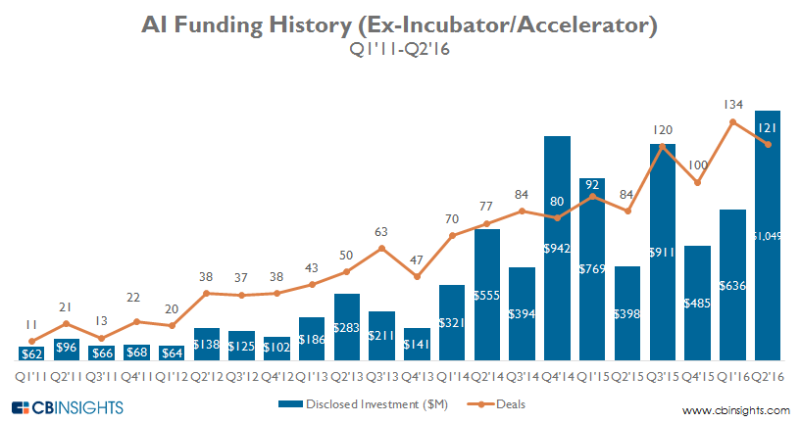Things have been really heating up since we saw the first wave of “conversational UI” companies in early 2015, and now there isn’t a week that goes by where we aren’t pitched a new chatbot app. While plenty has been written about the space, my sense is that there is still a great deal of confusion in the market. Many of the chatbot entrepreneurs I have spoken with recently still haven’t thought through some of the basic questions around the viability and positioning of their product within the broader marketplace. In this post, I’d like to share a few of the common questions that I have been asking chatbot entrepreneurs and offer some thoughts around each. (Despite Genacast’s focus on B2B, parts of this blog may still be applicable to consumer-oriented bots.)
Where in the vertical stack are you creating lasting value?
This is a difficult question to answer in any emerging sector where competitive dynamics are still evolving, but it’s important for founders to present thoughtful answers to this question.
With all of the NLP offerings announced from the Big Tech players (Google, IBM, Facebook, to name a few) in the last six months and the enormous amount of VC funding that has gone into AI tech, it has become a lot harder to build a value proposition simply around “better NLP”. If your startup is building NLP models from scratch, you should have a thorough explanation for why solutions like Wit.ai and Watson fall short and why you have chosen to reinvent (parts of) the wheel. While we’re still excited about highly technical teams that continue to push the boundaries on artificial intelligence, it’s important for us to understand what is it about your team or data collection that allows for superior results and how you are bench-marking your scores.
Another value proposition frequently heard is in tailoring basic semantic text analysis to specific use cases. I have heard from many founders that the defensibility of their business lies in being first-to-market in collecting data from a specific set of conversational interactions and that this training data is a significant barrier to entry. The idea here is that the more data you collect, the more conversation paths you can account for in automation, and the more scalable the solution. If this is your approach, be prepared to give an honest answer about what it’s going to take to train the model on these use cases and how you will be able to acquire this data in a capital efficient manner.
We’ve seen a number of companies attempt a human/bot hybrid with the goal of automating human activity over time by categorizing responses and prioritizing development resources on the automation tasks with the most bang for the buck. The virtual assistant for scheduling space is a great microcosm for this, and we’ve seen the staggering amount of capital required to pull this off within a narrowly defined use case. While it is still early days, the expense in scaling human moderation, the rarity of AI engineers, and new paradigms in bot development have made this approach a questionable choice for new companies.
I also want to know how important it is to have super-strong, tailored NLP models in the first place. As a general rule of thumb, 85% precision is more than adequate in many closed systems. The difficulty for competitors to hit this mark may be many times (read: many engineers) simpler than 95%+. In certain cases, the set of reasonable user queries may be much narrower in scope and an optimized solution might even be a rules-based response engine using regular expressions to parse for keywords.
Who do you compete against inside and outside of the messaging medium?
For folks new to this, the answer to “who do you compete against?” is almost never “no one”. In the case of chatbots, you should be familiar with a number of players in the space and associated risks.
If there is a Slack bot or FB bot with your functionality already, explain why your solution is better and why your competitors can’t easily copy your features or user acquisition strategy.
Beyond bots, I’m interested in who is offering a similar solution in more widespread mediums like web or mobile. In what way does the conversational aspect of your solution create a significant improvement over those existing solutions? There isn’t one right answer but I want to hear a thoughtful answer around the advantages of the medium itself so that I know this is more than opportunistic move on a new trend.
With the rise of bot creation platforms and bot developer kits, has it become possible for a non-technical founder to replicate the key features of your app? Many of these platforms use a number of pre-built templates, plug-and-play modules, integrations into various cloud services, and NLP baked in. If your startup’s advantage is in its ability to provide more customized experiences, tell me how you plan to maintain that edge over time as these services get better.
Another consideration is a close cousin of these bot platforms, the cloud workflow orchestration platform. A number of more mature companies that play in this space could very well pivot to support chatbots should the market take off.
The most dangerous competitor, however, is the product your app was built to support. If your chatbot is a conversational layer over a cloud-based service, your dependence on that underlying technology is a major risk. Twelve months ago, no one expected established cloud platforms to introduce their own AI-based conversation services. Today, many large enterprises are aware of the trend and have developed strategy around it. Whether you’re build as a skin over Salesforce, Shopify, or Zendesk, the existential risk in competing against this group is going to be a big concern. You should be able to address it head on.
[“The plan is to extend this beyond email. Zendesk is multi-channel and we’d want to include this in chat, voice, social channels and more traditional channels. We’d like to expand this to everything.”]
What is the ideal medium for this service?
Conversation can be a very productive medium for delivering business services, but limiting interaction to conversation is often an unproductive experience.
Does the solution need to be 100% in text? How do the addition of manual steps, yes/no buttons, or simple forms to the message stream affect the user experience? Making your “invisible app” slightly more visible can cut development time down quite significantly as you reduce the complexity in user queries.
I’m also keen to hear your thoughts on what platforms you’ve chosen to build on, whether it’s Slack, Facebook, Telegram, SMS, or otherwise. How do existing business processes tie into this decision? I want to get your view on how the market will play out for each of these platforms.
What does it take for this to become a big company?
Half of this question is “does this scale?”. I’ve touched on the challenges in scaling the technical architecture already, but this is also a question around go-to-market.
At this stage in the bot ecosystem, there are a number of challenges in customer acquisition. We’re still in very early days: there is a lot of buzz around the conversational service layer right now but not a lot of end user demand. Discovery is also an issue. It isn’t easy to find bots on Facebook unless you know what you’re looking for so it’s a bit of a wild west there at the moment. None of the existing “bot stores” have a mature interface for finding new bots and there aren’t any natural ways to market your bot yet. One approach that seems to be working for acquiring early customers has been working with distribution partners such agencies or legacy vendors.
The other part of this question is around market timing. For investors, being too early to an opportunity is the same as being too late. Today, there are a number of solutions that are gaining some traction on Slack, but I haven’t been able to find many instances of paid bot usage at the companies I’ve spoken to. I’m interested in hearing your perspective around when and how the end user demand will pick up.
I’m also watching the consumer bots space closely. I started conversations with a number of FB bots in the last few weeks. For the most part, these experiences have been disappointing, and surprisingly, many of the bots from big brands have not responded at all! (Side note: a big challenge for any bot platform is in vetting bots. Unlike mobile apps, some platforms aren’t able to see when developers push updates to their bots, as the backend mechanics of the bots are often hidden in a black box.) If my experience is any indication of the general quality of consumer bots, there’s also a risk that enthusiasm for B2B bots may dip before it picks back up due to preconceived notions of the new medium. Because of the market adoption issues, it may be helpful to have a contingency plan for the business in the event that a rising tide doesn’t arrive to lift all boats.
Final note:
At Genacast, we’re excited by the promise of bots for business. We believe there are a number of inefficient processes that can be creatively solved through the mediums of text and voice. If your team is building a new B2B-focused chatbot, I look forward to getting in touch.
Image credit: CC by ☰☵ Michele M. F.







